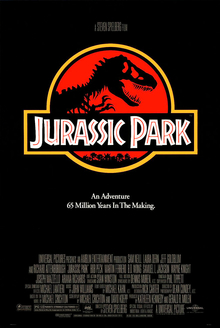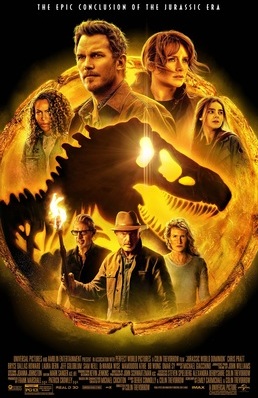
John Michael Crichton was an American author, screenwriter and filmmaker. His books have sold over 200 million copies worldwide, and over a dozen have been adapted into films. His literary works heavily feature technology and are usually within the science fiction, techno-thriller, and medical fiction genres. Crichton’s novels often explore human technological advancement and attempted dominance over nature, both with frequently catastrophic results; many of his works are cautionary tales, especially regarding themes of biotechnology. Several of his stories center specifically around themes of genetic modification, hybridization, paleontology and/or zoology. Many feature medical or scientific underpinnings, reflective of his own medical training and scientific background.

Jurassic Park is a 1993 American science fiction action film directed by Steven Spielberg, produced by Kathleen Kennedy and Gerald R. Molen, and starring Sam Neill, Laura Dern, Jeff Goldblum, and Richard Attenborough. It is the first installment in the Jurassic Park franchise, and the first film in the original Jurassic Park trilogy, and is based on Michael Crichton's 1990 novel of the same name, with a screenplay by Crichton and David Koepp. The film is set on the fictional island of Isla Nublar, off Central America's Pacific Coast near Costa Rica, where a wealthy businessman John Hammond (Attenborough), and a team of genetic scientists have created a wildlife park of de-extinct dinosaurs. When industrial sabotage leads to a catastrophic shutdown of the park's power facilities and security precautions, a small group of visitors, including Hammond's grandchildren, struggle to survive and escape the now perilous island.

The Lost World: Jurassic Park is a 1997 American science fiction action film. It is the second installment in the Jurassic Park franchise and the second film in the original Jurassic Park trilogy. A sequel to 1993's Jurassic Park and loosely based on Michael Crichton's 1995 novel The Lost World, the film was directed by Steven Spielberg from a screenplay by David Koepp. Jeff Goldblum, Richard Attenborough, Joseph Mazzello and Ariana Richards reprise their roles from the original film with Julianne Moore, Pete Postlethwaite, and Arliss Howard joining the cast.

Jurassic Park is a 1993 video game based on the film and novel of the same name. It was developed and published by Ocean Software and released for the Nintendo Entertainment System (NES). Ocean also ported the game onto the handheld Game Boy console.

Dr. Alan Grant is a fictional character in the Jurassic Park franchise. He is a paleontologist and is introduced in Michael Crichton's 1990 novel Jurassic Park, which began the franchise. Crichton based Grant on the paleontologist Jack Horner. Director Steven Spielberg helmed the 1993 film adaptation, and several actors were considered for the role of Grant. It ultimately went to Sam Neill, becoming one of his most popular roles. Spielberg gave the character a dislike of children, and put him in a relationship with Dr. Ellie Sattler, a paleobotanist who is Grant's student in the novel. Sattler, portrayed by Laura Dern, wants to start a family with Grant, who is resistant to the idea.

Jurassic World is a 2015 American science fiction action film directed by Colin Trevorrow, who co-wrote the screenplay with Rick Jaffa, Amanda Silver, and Derek Connolly from a story by Jaffa and Silver. It is the first installment in the Jurassic World trilogy and the fourth installment overall in the Jurassic Park film series, following Jurassic Park III (2001). The film stars Chris Pratt, Bryce Dallas Howard, Vincent D'Onofrio, Ty Simpkins, Nick Robinson, Omar Sy, BD Wong, and Irrfan Khan. Wong reprised his role from the original Jurassic Park film. Set 22 years after the events of Jurassic Park, Jurassic World takes place on the same fictional island of Isla Nublar, located off the Pacific coast of Costa Rica. A successful theme park of cloned dinosaurs, dubbed Jurassic World, has operated on the island for years, bringing John Hammond's dream to fruition. The park plunges into chaos when a transgenic dinosaur escapes from its enclosure and goes on a rampage, while a conspiracy orchestrated by the park's staff creates more dangers.

Jurassic Park: The Ride is a water-based amusement ride based on the Steven Spielberg 1993 film Jurassic Park and Michael Crichton's 1990 novel of the same name which the film is based on located at Universal Islands of Adventure in Orlando, Florida, and Universal Studios Japan in Osaka. It was formerly located at Universal Studios Hollywood in Universal City, California, where it was turned into Jurassic World: The Ride on July 12, 2019.

Dr. Ellie Sattler is a fictional character in the Jurassic Park franchise. She is introduced in Michael Crichton's 1990 novel Jurassic Park, which began the franchise. Steven Spielberg directed the 1993 film adaptation, casting Laura Dern as Sattler and giving the character a more substantial role compared to the novel. She is a paleobotanist in both the novel and its film adaptation. In the novel, she is a student of Dr. Alan Grant. For the film, Spielberg made them a romantic couple, with Sam Neill portraying Grant.

Jurassic Park, later also referred to as Jurassic World, is an American science fiction media franchise created by Michael Crichton and centered on a disastrous attempt to create a theme park of cloned dinosaurs. It began in 1990 when Universal Pictures and Amblin Entertainment bought the rights to Crichton's novel Jurassic Park before it was published. The book was successful, as was Steven Spielberg's 1993 film adaptation. The film received a theatrical 3D re-release in 2013, and was selected in 2018 for preservation in the United States National Film Registry by the Library of Congress as being "culturally, historically, or aesthetically significant". A 1995 sequel novel, The Lost World, was followed by a film adaptation in 1997. Subsequent films in the series from Jurassic Park III (2001) onward are not based on novels by Crichton.

The Lost World is a 1995 science fiction action novel written by Michael Crichton, and the sequel to his 1990 novel Jurassic Park. It is his tenth novel under his own name and his twentieth overall, and it was published by Knopf. A paperback edition (ISBN 0-345-40288-X) followed in 1996. In 1997, both novels were re-published as a single book titled Michael Crichton's Jurassic World, which is unrelated to the 2015 film of the same name.

Dr. John Hammond is a fictional character in the Jurassic Park franchise. He first appears in author Michael Crichton's 1990 novel Jurassic Park, which began the franchise. In Steven Spielberg's film adaptation of the same name, he was portrayed by Richard Attenborough, who reprised the role in the movie's sequel The Lost World: Jurassic Park.

Jurassic World Dominion is a 2022 American science fiction action film directed by Colin Trevorrow, who co-wrote the screenplay with Emily Carmichael from a story by Derek Connolly and Trevorrow. It is the sequel to Jurassic World: Fallen Kingdom (2018), the third and final installment in the Jurassic World trilogy, and the sixth installment overall in the Jurassic Park film series, concluding the storyline that began with Jurassic Park (1993). Chris Pratt, Bryce Dallas Howard, BD Wong, Daniella Pineda, Justice Smith, Isabella Sermon and Omar Sy reprise their roles from the previous films, along with Laura Dern, Jeff Goldblum, and Sam Neill, who appear together for the first time since the original Jurassic Park. New cast members include DeWanda Wise and Mamoudou Athie.
Production of the 2015 film Jurassic World was stalled for years in development hell while the film's storyline underwent numerous revisions. Development of the film, known then as Jurassic Park IV, began in 2001. William Monahan was announced as screenwriter in 2002, and the film was scheduled for a 2005 release. When Monahan left to work on another project, he was replaced in 2004 by John Sayles. By 2005, the start of production had stalled, as executive producer Steven Spielberg was not satisfied with any of the script drafts. In 2006, Jurassic Park III director Joe Johnston was set to direct the film, which was subsequently expected for release in 2008. By 2010, filming had yet to begin. Johnston and Spielberg intended to work on the film following the completion of their own respective film projects. Writer Mark Protosevich was hired in 2011, although two story treatments by him were rejected.

Dr. Ian Malcolm is a fictional character from the Jurassic Park franchise created by Michael Crichton and portrayed by Jeff Goldblum. Malcolm is a gifted mathematician who specializes in chaos theory. The character was inspired in part by American historian of science James Gleick and French mathematician Ivar Ekeland. In Crichton's 1990 novel Jurassic Park and its 1993 film adaptation, Malcolm is invited by insurance lawyer Donald Gennaro to notice any problems with John Hammond's dinosaur theme park, Jurassic Park. Malcolm was intended by Crichton to fill in the role of the audience in the scenarios he is put through. Malcolm is a secondary protagonist in the original novel and the main protagonist in the sequel, The Lost World, due to positive fan reception from Goldblum's performance as the character in director Steven Spielberg's film adaptation of the original novel.

Lego Jurassic World is a Lego theme based on the Jurassic World media franchise created by Michael Crichton and centered on a disastrous attempt to create a theme park of cloned dinosaurs. It is licensed from Universal Studios and Amblin Entertainment. The theme was introduced in June 2015, with the release of toy sets and the video game Lego Jurassic World, both to promote the film Jurassic World. Subsequent sets were released in 2018, alongside the next film, Jurassic World: Fallen Kingdom. Various animated projects have also been made, including the 2018 television special Lego Jurassic World: The Secret Exhibit, and the 2019 miniseries Lego Jurassic World: Legend of Isla Nublar.

Jurassic Park, later also referred to as Jurassic World, is an American science fiction adventure media franchise. It focuses on the cloning of dinosaurs through ancient DNA, extracted from mosquitoes that have been fossilized in amber. The franchise explores the ethics of cloning and genetic engineering, and the morals behind de-extinction.

Dr. Henry Wu is a fictional character in the Jurassic Park franchise. He is introduced in Michael Crichton's 1990 novel Jurassic Park, which began the franchise. He also appears briefly in the novel's 1993 film adaptation and plays a larger role in the Jurassic World film trilogy. Dr. Wu is the lead geneticist for the dinosaur theme parks Jurassic Park and Jurassic World, overseeing the de-extinction of dinosaurs through genetic engineering. He is killed by a Velociraptor in the novel, but survives throughout the film series, in which he is portrayed by actor BD Wong. Although Wu is a supporting character in the novel, he has a drastically reduced role in the film adaptation, directed by Steven Spielberg. Wong and Wu are both Asian-American, and the actor believed that the role was reduced, to his disappointment, because of "racial exclusion in Hollywood".

Rexy is the colloquial nickname for a fictional Tyrannosaurus rex that appears throughout the Jurassic Park franchise. She first appeared in Michael Crichton's 1990 novel Jurassic Park, and made her onscreen debut in the 1993 film adaptation, directed by Steven Spielberg. She returns in the 2015 film Jurassic World and its sequels, Jurassic World: Fallen Kingdom (2018) and Jurassic World Dominion (2022).

Maisie Lockwood is a fictional character in the Jurassic Park franchise. She is introduced in the fifth film, Jurassic World: Fallen Kingdom (2018), which is also the second installment in the Jurassic World trilogy. J. A. Bayona directed the film, casting Isabella Sermon as Maisie. She is one of the three main protagonists in the Jurassic World trilogy, along with her adoptive parents, Owen Grady and Claire Dearing. She used to live with her late grandfather Sir Benjamin Lockwood, an old business partner of Dr. John Hammond. She is the biogenetic daughter of geneticist Charlotte Lockwood.



















